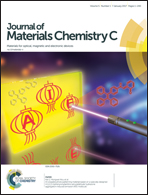Structure and magnetism of the solid solution GexFe4−xNy (0 ≤ x ≤ 1): from a ferromagnet to a spin glass
Abstract
We present an experimental and theoretical study of the solid solution GexFe4−xNy (0 ≤ x ≤ 1). A two-step ammonolytic reaction gives access to the compounds with phase-pure quality. The GexFe4−xNy nitrides show a transition from an antiperovskite-like to a tetragonally distorted structure with increasing germanium concentration. Various experimental and theoretical methods evidence that the iron substitution by germanium exclusively takes place at the cubic Wyckoff position 1a. Despite the phase transition, one observes a Vegard-type decrease of the lattice parameter over the entire compositional range. In addition, the nitrides have a limited nitrogen capacity: incorporating germanium drastically reduces the nitrogen content in the cubic structure, but increases it again in the tetragonal structure. Combined HT-XRD and TG-DSC measurements evidence that the germanium-richest nitrides are highly expanding materials. They first show a transition to a cubic structure before they decompose by releasing nitrogen. Magnetic measurements reveal that the gradual germanium incorporation is accompanied by a drastic weakening of the ferromagnetic interactions leading to a frustrated iron spin system. Ge0.97Fe3.03N0.56 is identified as a canonical spin glass with the characteristic parameters Tg = 36.68(5) K, τ* = 10−13.8(2) s, zν = 7.2(1) and ΔTm/(Tm·Δ lg ω) = 0.012.



 Please wait while we load your content...
Please wait while we load your content...